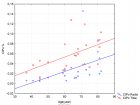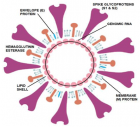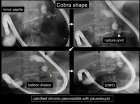Abstract
Review Article
Pigeonpea sterility mosaic virus a green plague-Current status of available drug and new potential targets
Nisha Singh*, Bhawna Narula, Megha Ujinwal and Sapna Langyan
Published: 14 June, 2021 | Volume 5 - Issue 1 | Pages: 008-026
Pigeonpea is one of the important legume crops with high protein content and nutritional traits. It has enormous potency for its widespread adoption by farming communities. It is affected by various kinds of biotic and abiotic stresses. In the context, of biotic stresses Sterility mosaic disease (SMD) is one of the severe diseases in pigeonpea which ultimately lead to the drastic yield loss. The virus belongs to the genus Emaravirus, family- Fimoviridae. SMD is associated with two diverse types of Emaravirus, Pigeonpea sterility mosaic virus1 (PPSMV-1) and Pigeonpea sterility mosaic virus 2 (PPSMV-2). It is transmitted by the mite (Aceria cajani), mainly environmental contributing to the feasibility for the mites for the inoculation of the virus. The SMD is mainly governed by two genes SV1 that includes the dominant allele and serves as an inhibitory action on the resistance of the SV2. Methods for identification of the virus include RT-PCR, DIBA and ELISA using alkaline phosphatase or penicillinase. To control SMV disease farmers generally adopted intercropping methods. There are few potential drugs have been identified for the administration of the disease such as 0.1% Fenazaquin, Dicofol, Imidacloripid, Carbosulfan; Spiromesifin includes the inhibition of the mite inoculation on the pigeonpea plant. The present review describes compressive and systematic insights on SMV protein targets and potential drugs that could be utilized as the presumed drug targets for the finding of true drugs against the SMD in pigeonpea.
Read Full Article HTML DOI: 10.29328/journal.apb.1001013 Cite this Article Read Full Article PDF
Keywords:
Drug targets; Emaravirus; Pigeonpea; Protein structure SMD; SMV1 and SMV2
References
- Simtowe F, Shiferaw B, Kassie M, Abate T, Silim S, et al. Assessment of the current situation and future outlooks for the pigeonpea sub-sector in Malawi. Nairobi: ICRISAT. 2010.
- Bohra A, Saxena KB, Varshney RK, Saxena RK. Genomics-assisted breeding for pigeonpea improvement. Theoreti Appl Gene. 2020; 133: 1721-1737. PubMed: https://pubmed.ncbi.nlm.nih.gov/32062675/
- Singh N, Rai V, Singh NK. Multi-omics strategies and prospects to enhance seed quality and nutritional traits in pigeonpea. Nucleus. 2020; 63: 249–256.
- Varshney RK, Chen W, Li Y, Bharti AK, Saxena RK, et al. Draft genome sequence of pigeonpea (Cajanus cajan: an orphan legume crop of resource-poor farmers. Nat Biotechnol. 2012; 30: 83-89.
- Zavinon F, Adoukonou-Sagbadja H, Keilwagen J, Lehnert H, Ordon F, et al. Genetic diversity and population structure in Beninese pigeon pea [Cajanus cajan (L.) Huth] landraces collection revealed by SSR and genome wide SNP markers. Gene Resour Crop Evolut. 2020; 67: 191-208.
- Raisch MJ. Website and Database Survey 2016. J Int Econo Law. 2017; 20: 189-195.
- Mitra M. Report of the Imperial Mycologist. Report of the Imperial Mycologist. 1931.
- Kumar PL, Jones AT, Sreenivasulu P, Reddy DVR. Breakthrough in the identification of the causal virus of pigeonpea sterility mosaic disease. J Mycol Plant Pathol. 2000; 30.
- Jones AT, Kumar PL, Saxena KB, Kulkarni NK, Muniyappa V, et al. Sterility mosaic disease—the “green plague” of pigeonpea: advances in understanding the etiology, transmission and control of a major virus disease. Plant Dis. 2004; 88: 436-445. PubMed: https://pubmed.ncbi.nlm.nih.gov/30812645/
- Rani CS, Rani CSKS. Effect of different intercrops on growth and yield of pigeonpea in a paired row planting system. IJCS. 200; 8: 2258-2261.
- Kulkarni NK, Kumar PL, Muniyappa V, Jones AT, Reddy DVR. Transmission of Pigeon pea sterility mosaic virus by the eriophyid mite, Aceriacajani (Acari: Arthropoda). Plant Dis. 2002; 86: 1297-1302. PubMed: https://pubmed.ncbi.nlm.nih.gov/30818431/
- Patil BL, Dangwal M, Mishra R. Variability of Emaravirus species associated with sterility mosaic disease of pigeonpea in India provides evidence of segment reassortment. Viruses. 2017; 9: 183. PubMed: https://pubmed.ncbi.nlm.nih.gov/28696402/
- Saxena K, Bohra A, Choudhary AK, Sultana R, Sharma M, et al. The alternative breeding approaches for improving yield gains and stress response in pigeonpea (Cajanus cajan). Plant Breeding. 2021; 140: 74-86.
- Nawaz KA, David SM, Murugesh E, Thandeeswaran M, Kiran KG, et al. Identification and in silico characterization of a novel peptide inhibitor of angiotensin converting enzyme.pigeon pea (Cajanus cajan). Phytomedicine. 2017; 36: 1-7. PubMed: https://pubmed.ncbi.nlm.nih.gov/29157802/
- Dipshikha K, Seweta S, Chandra NB, Chauhan VB, Singh RN. Correlation between mite population (Aceriacajani) and environmental factors causing sterility mosaic disease of Pigeon pea. Int J Life Sci. 2013; 1: 228-232.
- Pedersen P, Grau C, Cullen E, Koval N, Hill JH. Potential for integrated management of soybean virus disease. Plant Dis. 2007; 91: 1255-1259. PubMed: https://pubmed.ncbi.nlm.nih.gov/30780527/
- Hill JH, Whitham SA. Control of virus diseases in soybeans. Adv Virus Res. 2014; 90: 355-390. PubMed: https://pubmed.ncbi.nlm.nih.gov/25410106/
- Elbeaino T, Digiaro M, Uppala M, Sudini H. Deep sequencing of pigeonpea sterility mosaic virus discloses five RNA segments related to Emaraviruses. Virus Res. 2014; 188: 27-31. PubMed: https://pubmed.ncbi.nlm.nih.gov/24685674/
- Sayiprathap BR, Patibanda AK, Kumari VP, Jayalalitha K, Rao V.S, et al. Prevalence of sterility mosaic disease (SMD) and variability in pigeonpea sterility mosaic virus (PPSMV) in southern-India. Indian Phytopathol. 2020; 1-10.
- Mielke-Ehret N, Mühlbach HP. Emaravirus: a novel genus of multipartite, negative strand RNA plant viruses. Viruses. 2012; 4: 1515-1536. PubMed: https://pubmed.ncbi.nlm.nih.gov/23170170/
- Kumar PL, Jones AT, Reddy DVR. A novel mite-transmitted virus with a divided RNA genome closely associated with pigeonpea sterility mosaic disease. Phytopathology. 2003; 93: 71-81. PubMed: https://pubmed.ncbi.nlm.nih.gov/18944159/
- Saxena KB, Lava Kumar P, Kulkarni NK, Jones AT, Muniyappa V, et al. Sterility mosaic disease the green plague of pigeonpea. Plant Dis. 2004; 88: 436-445.
- Singh NK, Gupta DK, Jayaswal PK, Mahato AK, Dutta S, Singh S, et al. The first draft of the pigeonpea genome sequence. J Plant Biochem Biotechnol. 2012; 21: 98-112. PubMed: https://pubmed.ncbi.nlm.nih.gov/24431589/
- Kulkarni NK, Kumar PL, Muniyappa V, Jones AT, Reddy DVR. Transmission of Pigeon pea sterility mosaic virus by the eriophyid mite, Aceriacajani (Acari: Arthropoda). Plant Dis. 2002; 86: 1297-1302. PubMed: https://pubmed.ncbi.nlm.nih.gov/30818431/
- Saxena KB, Lava Kumar P, Kulkarni NK, Jones AT, Muniyappa V, et al. Sterility mosaic disease the green plague of pigeonpea. Plant Dis. 2004; 88: 436-445. PubMed: https://pubmed.ncbi.nlm.nih.gov/30812645/
- Latha TKS, Sabitha D. Interaction studies between pigeonpea sterility mosaic virus and mite vector. Indian J Plant Protection. 2004; 32: 105-110.
- Jones AT, Kumar PL, Saxena KB, Kulkarni NK, Muniyappa V, et al. Sterility mosaic disease—the “green plague” of pigeonpea: advances in understanding the etiology, transmission and control of a major virus disease. Plant Dis. 2004; 88: 436-445. PubMed: https://pubmed.ncbi.nlm.nih.gov/30812645/
- Gnanesh BN, Bohra A, Sharma M, Byregowda M, Pande S, et al. Genetic mapping and quantitative trait locus analysis of resistance to sterility mosaic disease in pigeonpea [Cajanus cajan (L.) Millsp.]. Field Crops Res. 2011; 123: 53-61.
- Latha TKS, Doraiswamy S. Detection of pigeonpea sterility mosaic virus, the causal agent of sterility mosaic disease of pigeonpea in viruliferous mite vector by DAS-ELISA and DIBA. Arch Phytopathol Plant Protect. 2008; 41: 537-541.
- Elbeaino T, Digiaro M, Uppala M, Sudini H. Deep sequencing of dsRNAs recovered.mosaic-diseased pigeonpea reveals the presence of a novel Emaravirus: pigeonpea sterility mosaic virus 2. Arch Virol. 2015; 160: 2019-2029. PubMed: https://pubmed.ncbi.nlm.nih.gov/26060057/
- Rajeswari E, Smitha KP, Kamalakannan A, Alice D, Bapu JK. Management of pigeonpea sterility mosaic disease. Legume Res. 2016; 39: 648-650.
- Pazhamala L, Saxena RK, Singh VK, Sameerkumar CV, Kumar V, Sinha P, et al. Genomics-assisted breeding for boosting crop improvement in pigeonpea (Cajanus cajan). Front Plant Sci. 2015; 6: 50. PubMed: https://pubmed.ncbi.nlm.nih.gov/25741349/
- Kumar PL, Latha TKS, Kulkarni NK, Raghavendra N, Saxena KB, et al. Broad‐based resistance to pigeonpea sterility mosaic disease in wild relatives of pigeonpea (Cajanus: Phaseoleae). Ann Appl Biol. 2005; 146: 371-379.
- Saxena RK, Kale S, Mir RR, Mallikarjuna N, Yadav P, et al. Genotyping-by-sequencing and multilocation evaluation of two interspecific backcross populations identify QTLs for yield-related traits in pigeonpea. Theoreti Appl Genet. 2020; 133: 737-749. PubMed: https://pubmed.ncbi.nlm.nih.gov/31844966/
- Sharma M, Rathore A, Mangala UN, Ghosh R, Sharma S, et al. New sources of resistance to Fusarium wilt and sterility mosaic disease in a mini-core collection of pigeonpea germplasm. Eur J Plant Pathol. 2012; 133: 707-714.
- Odeny DA, Githiri SM, Kimani PM. Inheritance of resistance to Fusarium wilt in pigeonpea {Cajanus cajan (L.) Millsp. 2009.
- Bhairappanavar SB, Fakrudin B, Rao KS. Inheritance Studies of Sterility Mosaic Disease (SMD) Resistance Cross Gullyalwhite×BSMR736 in Pigeonpea (Cajanus cajan (L.) Millsp.). Plant Gene Trait. 2014; 5.
- Raju NL, Gnanesh BN, Lekha P, Jayashree B, Pande S, et al. The first set of EST resource for gene discovery and marker development in pigeonpea (Cajanus Cajan L.). BMC Plant Biol. 2010; 10: 1-22.
- Singh S, Mahato AK, Jayaswal PK, Singh N, Dheer M, Goel P, et al. A 62K genic-SNP chip array for genetic studies and breeding applications in pigeonpea (Cajanus Cajan L. Millsp.). Sci Rep. 2020; 10: 1-14.
- Saxena KB, Lava Kumar P, Kulkarni NK, Jones AT, Muniyappa V, et al. Sterility mosaic disease the green plague of pigeonpea. Plant Dis. 2004; 88: 436-445. PubMed: https://pubmed.ncbi.nlm.nih.gov/30812645/
- Ujinwal M, Sahani PA, Singh N. Comparative Sequence and Structural Analysis of Lectin Protein in Chickpea (Cicer arietinum L.) and their Relationship with fabaceae Family. J Biomed Res Environ Sci. 2019; 5: 001-006.
- Mula MG, Saxena KB. Lifting the level of awareness on pigeonpea-a global perspective. International Crops Research Institute for the Semi-Arid Tropics. 2010.
- Kumar PL, Jones AT, Waliyar F. Biology, etiology and management of pigeonpea sterility mosaic. Ann Rev Plant Pathol. 2005; 3: 77-100.
- Kumar PL, Jones AT, Reddy DVR. Saxena KB, Lava Kumar P, et al. Sterility mosaic disease the green plague of pigeonpea. Plant Dis. 2003; 2004; 88: 436-445.
- Singh NK, Gupta DK, Jayaswal PK, Mahato AK, Dutta S, et al. The first draft of the pigeonpea genome sequence. J Plant Biochem Biotechnol. 2012; 21: 98-112. PubMed: https://pubmed.ncbi.nlm.nih.gov/24431589/
- Kulkarni NK, Kumar PL, Muniyappa V, Jones AT, Reddy DVR. Transmission of Pigeon pea sterility mosaic virus by the eriophyid mite, Aceriacajani (Acari: Arthropoda). Plant Dis. 2002; 86: 1297-1302. PubMed: https://pubmed.ncbi.nlm.nih.gov/30818431/
- Rajeswari E, Smitha KP, Kamalakannan A, Alice D, Bapu JK. Management of pigeonpea sterility mosaic disease. Legume Res. 2016 39: 648-650.
- https://pubchem.ncbi.nlm.nih.gov/compound/8268National Center for Biotechnology Information (2021). PubChem Compound Summary for CID 6624, Chlorfenethol. 2021. https://pubchem.ncbi.nlm.nih.gov/compound/Chlorfenethol.
- National Center for Biotechnology Information (2021). PubChem Compound Summary for CID 26450, Proclonol. 2021. https://pubchem.ncbi.nlm.nih.gov/compound/Proclonol.
- National Center for Biotechnology Information (2021). PubChem Compound Summary for CID 14189996, 1-(4-Chlorophenyl)-1-phenylethanol. 2021. https://pubchem.ncbi.nlm.nih.gov/compound/1-_4-Chlorophenyl_-1-phenylethanol.
- National Center for Biotechnology Information (2021). PubChem Compound Summary for CID 160701, 2,2-Dichloro-1,1-bis(4-chlorophenyl)ethanol. 2021. https://pubchem.ncbi.nlm.nih.gov/compound/2_2-Dichloro-1_1-bis_4-chlorophenyl_ethanol.
- National Center for Biotechnology Information (2021). PubChem Compound Summary for CID 11348842. https://pubchem.ncbi.nlm.nih.gov/compound/11348842.
- National Center for Biotechnology Information (2021). PubChem Compound Summary for CID 146570, Escitalopram. https://pubchem.ncbi.nlm.nih.gov/compound/Escitalopram.
- National Center for Biotechnology Information (2021). PubChem Compound Summary for CID 86287518. https://pubchem.ncbi.nlm.nih.gov/compound/Imidacloprid.
- National Center for Biotechnology Information (2021). PubChem Compound Summary for CID 47759, Furathiocarb. https://pubchem.ncbi.nlm.nih.gov/compound/Furathiocarb.
- National Center for Biotechnology Information (2021). PubChem Compound Summary for CID 54886, Benfuracarb. https://pubchem.ncbi.nlm.nih.gov/compound/Benfuracarb.
- National Center for Biotechnology Information (2021). PubChem Compound Summary for CID 47756. https://pubchem.ncbi.nlm.nih.gov/compound/47756.
- National Center for Biotechnology Information (2021). PubChem Compound Summary for CID 3067994. https://pubchem.ncbi.nlm.nih.gov/compound/3067994.
- National Center for Biotechnology Information (2021). PubChem Compound Summary for CID 131676698, Lactoferrin (322-329) (human). https://pubchem.ncbi.nlm.nih.gov/compound/Lactoferrin-_322-329_-_human.
- National Center for Biotechnology Information (2021). PubChem Compound Summary for CID 456832. https://pubchem.ncbi.nlm.nih.gov/compound/456832.
- National Center for Biotechnology Information (2021). PubChem Compound Summary for CID 6249, Ampicillin. https://pubchem.ncbi.nlm.nih.gov/compound/Ampicillin.
- National Center for Biotechnology Information (2021). PubChem Compound Summary for CID 5904, Penicillin g. https://pubchem.ncbi.nlm.nih.gov/compound/Penicillin-g.
- National Center for Biotechnology Information (2021). PubChem Compound Summary for CID 72493, Matromycin. https://pubchem.ncbi.nlm.nih.gov/compound/Matromycin.
- National Center for Biotechnology Information (2021). PubChem Compound Summary for CID 447043, Azithromycin. https://pubchem.ncbi.nlm.nih.gov/compound/Azithromycin.
- National Center for Biotechnology Information (2021). PubChem Compound Summary for CID 3779, Isoproterenol. https://pubchem.ncbi.nlm.nih.gov/compound/Isoproterenol.
- National Center for Biotechnology Information (2021). PubChem Compound Summary for CID 493570, Riboflavin. https://pubchem.ncbi.nlm.nih.gov/compound/Riboflavin.
- National Center for Biotechnology Information (2021). PubChem Compound Summary for CID 174174, Atropine. 2021. https://pubchem.ncbi.nlm.nih.gov/compound/Atropine.
- National Center for Biotechnology Information (2021). PubChem Substance Record for SID 349974776, Source: Therapeutic Target Database (TTD). 2021.https://pubchem.ncbi.nlm.nih.gov/substance/349974776.
- National Center for Biotechnology Information (2021). PubChem Compound Summary for CID 8378, Neomycin. 2021. https://pubchem.ncbi.nlm.nih.gov/compound/Neomycin.
- National Center for Biotechnology Information (2021). PubChem Compound Summary for CID 25074253. 2021. https://pubchem.ncbi.nlm.nih.gov/compound/25074253.
- National Center for Biotechnology Information (2021). PubChem Compound Summary for CID 13903189. 2021. https://pubchem.ncbi.nlm.nih.gov/compound/13903189.
- National Center for Biotechnology Information (2021). PubChem Compound Summary for CID 17856126, 1H-Diazepine-7-carboxylate. 2021. https://pubchem.ncbi.nlm.nih.gov/compound/1H-Diazepine-7-carboxylate.
- National Center for Biotechnology Information (2021). PubChem Compound Summary for CID 44588235, Ningnanmycin. 2021. https://pubchem.ncbi.nlm.nih.gov/compound/Ningnanmycin.
- National Center for Biotechnology Information (2021). PubChem Compound Summary for CID 37542, Ribavirin. 2021. https://pubchem.ncbi.nlm.nih.gov/compound/Ribavirin.
- National Center for Biotechnology Information (2021). PubChem Compound Summary for CID 5090648, (+/-)-Tylophorine. 2021. https://pubchem.ncbi.nlm.nih.gov/compound/5090648.
- National Center for Biotechnology Information (2021). PubChem Compound Summary for CID 92765, Cryptopleurine. 2021. https://pubchem.ncbi.nlm.nih.gov/compound/Cryptopleurine.
- National Center for Biotechnology Information (2021). PubChem Compound Summary for CID 639288. 2021. https://pubchem.ncbi.nlm.nih.gov/compound/639288.
- National Center for Biotechnology Information (2021). PubChem Compound Summary for CID 100252, Ribavirin monophosphate. 2021. https://pubchem.ncbi.nlm.nih.gov/compound/Ribavirin-monophosphate.
- National Center for Biotechnology Information (2021). PubChem Compound Summary for CID 5064, Virazole. 2021. https://pubchem.ncbi.nlm.nih.gov/compound/Virazole.
- National Center for Biotechnology Information (2021). PubChem Compound Summary for CID 460516, Levovirin. 2021. https://pubchem.ncbi.nlm.nih.gov/compound/Levovirin.
- National Center for Biotechnology Information (2021). PubChem Compound Summary for CID 44443369, Tylophorinicine. 2021. https://pubchem.ncbi.nlm.nih.gov/compound/Tylophorinicine.
- National Center for Biotechnology Information (2021). PubChem Compound Summary for CID 36294, Tobramycin. 2021. https://pubchem.ncbi.nlm.nih.gov/compound/Tobramycin.
- National Center for Biotechnology Information (2021). PubChem Compound Summary for CID 451447, Taribavirin hydrochloride. 2021. https://pubchem.ncbi.nlm.nih.gov/compound/Taribavirin-hydrochloride.
- National Center for Biotechnology Information (2021). PubChem Compound Summary for CID 451949. 2021. https://pubchem.ncbi.nlm.nih.gov/compound/451949.
- National Center for Biotechnology Information (2021). PubChem Compound Summary for CID 8378, Neomycin. 2021. https://pubchem.ncbi.nlm.nih.gov/compound/Neomycin\
- National Center for Biotechnology Information (2021). PubChem Compound Summary for CID 16212126. 2021. https://pubchem.ncbi.nlm.nih.gov/compound/16212126
Figures:

Figure 1
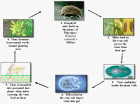
Figure 2

Figure 3

Figure 4

Figure 5

Figure 6
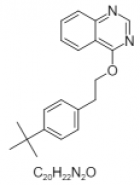
Figure 7
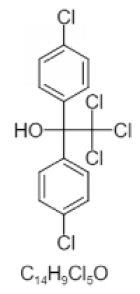
Figure 8
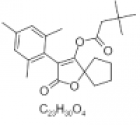
Figure 9
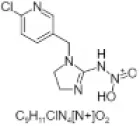
Figure 10
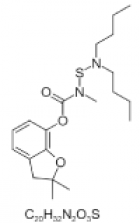
Figure 11
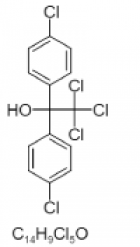
Figure 12
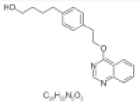
Figure 13
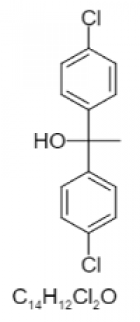
Figure 14

Figure 15
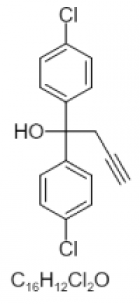
Figure 16
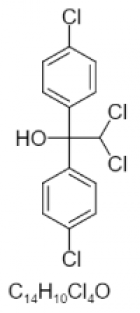
Figure 17
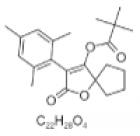
Figure 18
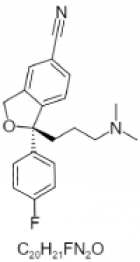
Figure 19
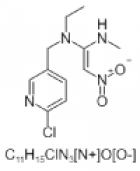
Figure 20

Figure 21

Figure 22

Figure 23

Figure 24
Similar Articles
-
Pigeonpea sterility mosaic virus a green plague-Current status of available drug and new potential targetsNisha Singh*,Bhawna Narula,Megha Ujinwal,Sapna Langyan. Pigeonpea sterility mosaic virus a green plague-Current status of available drug and new potential targets. . 2021 doi: 10.29328/journal.apb.1001013; 5: 008-026
Recently Viewed
-
The Color of Diseases and Herbs-chromatic Illustrating the Yin-yang Regulation Theory in Traditional Chinese MedicineHuigang Liu*. The Color of Diseases and Herbs-chromatic Illustrating the Yin-yang Regulation Theory in Traditional Chinese Medicine. Ann Biomed Sci Eng. 2025: doi: 10.29328/journal.abse.1001034; 9: 001-004
-
Mass Serological Screening in the Armed Forces Using the Serum-Pooling Method. Analytical Evaluation of the Chemiluminescence MethodAbi R*,Ameur O,Hassine S,Chanhih N,Ouannass S,Goura H,Eddaif KH,Elkochri S,Aadi Y,Elbenaissi Y,Tagajdid MR,Elannaz H,Laraqui A,Elmchichi B,Touil N,Kasouati J,Elouennass M,Ennibi K,Lahlou IA. Mass Serological Screening in the Armed Forces Using the Serum-Pooling Method. Analytical Evaluation of the Chemiluminescence Method. Int J Clin Virol. 2025: doi: 10.29328/journal.ijcv.1001062; 9: 001-004
-
The evolving landscape of ENT disorder treatments: Recent advances and innovations (2019-2021) – A CommentaryYRKM Sai*. The evolving landscape of ENT disorder treatments: Recent advances and innovations (2019-2021) – A Commentary. Adv Treat ENT Disord. 2021: doi: 10.29328/journal.ated.1001012; 5: 001-004
-
Retracted: Comparison of Effect of Intrathecal Fentanyl 25µg with 0.5% Hyperbaric Bupivacaine and Only 0.5% Hyperbaric BupivacaineParveen Gafla*. Retracted: Comparison of Effect of Intrathecal Fentanyl 25µg with 0.5% Hyperbaric Bupivacaine and Only 0.5% Hyperbaric Bupivacaine. Int J Clin Anesth Res. 2025: doi: 10.29328/journal.ijcar.1001029; 9: 017-022
-
Septic Shock on Bartholinitis: Case Report and Modern Surgical ApproachesOumaima Fakir*,Hanaa Lazhar,Aziz Slaoui,Amina Lakhdar,Aziz Baydada. Septic Shock on Bartholinitis: Case Report and Modern Surgical Approaches. Clin J Obstet Gynecol. 2025: doi: 10.29328/journal.cjog.1001183; 8: 015-018
Most Viewed
-
Feasibility study of magnetic sensing for detecting single-neuron action potentialsDenis Tonini,Kai Wu,Renata Saha,Jian-Ping Wang*. Feasibility study of magnetic sensing for detecting single-neuron action potentials. Ann Biomed Sci Eng. 2022 doi: 10.29328/journal.abse.1001018; 6: 019-029
-
Evaluation of In vitro and Ex vivo Models for Studying the Effectiveness of Vaginal Drug Systems in Controlling Microbe Infections: A Systematic ReviewMohammad Hossein Karami*, Majid Abdouss*, Mandana Karami. Evaluation of In vitro and Ex vivo Models for Studying the Effectiveness of Vaginal Drug Systems in Controlling Microbe Infections: A Systematic Review. Clin J Obstet Gynecol. 2023 doi: 10.29328/journal.cjog.1001151; 6: 201-215
-
Causal Link between Human Blood Metabolites and Asthma: An Investigation Using Mendelian RandomizationYong-Qing Zhu, Xiao-Yan Meng, Jing-Hua Yang*. Causal Link between Human Blood Metabolites and Asthma: An Investigation Using Mendelian Randomization. Arch Asthma Allergy Immunol. 2023 doi: 10.29328/journal.aaai.1001032; 7: 012-022
-
Impact of Latex Sensitization on Asthma and Rhinitis Progression: A Study at Abidjan-Cocody University Hospital - Côte d’Ivoire (Progression of Asthma and Rhinitis related to Latex Sensitization)Dasse Sery Romuald*, KL Siransy, N Koffi, RO Yeboah, EK Nguessan, HA Adou, VP Goran-Kouacou, AU Assi, JY Seri, S Moussa, D Oura, CL Memel, H Koya, E Atoukoula. Impact of Latex Sensitization on Asthma and Rhinitis Progression: A Study at Abidjan-Cocody University Hospital - Côte d’Ivoire (Progression of Asthma and Rhinitis related to Latex Sensitization). Arch Asthma Allergy Immunol. 2024 doi: 10.29328/journal.aaai.1001035; 8: 007-012
-
An algorithm to safely manage oral food challenge in an office-based setting for children with multiple food allergiesNathalie Cottel,Aïcha Dieme,Véronique Orcel,Yannick Chantran,Mélisande Bourgoin-Heck,Jocelyne Just. An algorithm to safely manage oral food challenge in an office-based setting for children with multiple food allergies. Arch Asthma Allergy Immunol. 2021 doi: 10.29328/journal.aaai.1001027; 5: 030-037

If you are already a member of our network and need to keep track of any developments regarding a question you have already submitted, click "take me to my Query."






